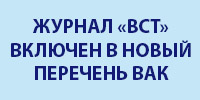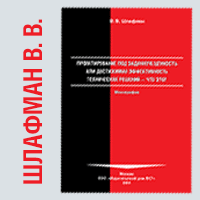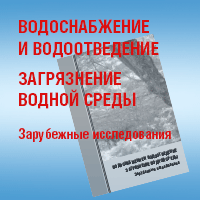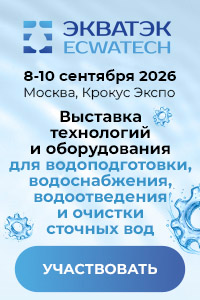№3|2025
DRINKING WATER SUPPLY
UDC 628.161.3:628.166
DOI 10.35776/VST.2025.03.01
Drastic reduction of trihalomethane concentration
in domestic water supply systems
Summary
Disinfection stage that guarantees the safety of drinking water in epidemiological terms is mandatory in the process of water treatment. One of the main disinfection methods is chlorination with chlorine or hypochlorites. As a result, chlororganics are generated in drinking water. Some representatives of this class of compounds – trihalomethanes pose a danger to human health, producing a carcinogenic, mutagenic effect, and accumulating in the body. In this regard, the sanitary legislation strictly regulates the concentration of these compounds in drinking water, and the standards for them continuously toughen. Reducing the concentration or limiting the generation of trihalomethanes in drinking water has been an urgent task, and for the purpose of solving this task a number of technical methods are proposed. A promising method of water disinfection is presented that provides for almost complete elimination of trihalomethane generation; namely processing water with «Chlorine dioxide and chlorine» disinfectant, obtained in local automated installations of «DH-100» type. As the practice of implementing this method at more than 50 water treatment facilities in Russia and Kazakhstan has shown, the method provides for reducing trihalomethane concentrations, including water supply sources containing bromides, up to their complete elimination, while ensuring complete disinfection and safety of drinking water.
Key words
potable water , disinfection , bioreactor , water treatment , ozone , trihalomethanes , chlororganic compounds , chlorine , chlorine dioxide , preammoniation , hypochlorites , bromides
For citation: Veselovskaya T. G., Svintsitsky V. A. Drastic reduction of trihalomethane concentration in domestic water supply systems. Vodosnabzhenie i Sanitarnaia Tekhnika, 2025, no. 3, pp. 4–11. DOI: 10.35776/VST.2025.03.01. (In Russian).
The further text is accessible on a paid subscription.
For authorisation enter the login/password.
Or subscribe
REFERENCES
- Егорова Н. А., Букшук А. А., Красовский Г. Н. Гигиеническая оценка продуктов хлорирования питьевой воды с учетом множественности путей поступления в организм // Гигиена и санитария. 2013. № 2. С. 18–24.
Egorova N. A., Bukshuk A. A., Krasovskii G. N. [Hygienic estimation of drinking water chlorination products taking into account the multiple routes of entry into the body]. Gigiena i Sanitariia, 2013, no. 2, pp. 18–24. (In Russian). - Куцева Н. К., Пирогова С. В. Старые проблемы и новые вопросы для лабораторий: физико-химические показатели качества воды // Контроль качества продукции. 2022. № 6. С. 16–22.
Kutseva N. K., Pirogova S. V. [Old problems and new questions for laboratories: physical and chemical indicators of water quality]. Kontrol’ Kachestva Produktsii, 2022, no. 6, pp. 16–22. (In Russian). - Lockle D. M., Schcter A. J., Christian J. J. Effects of chloroform, tetrachlorethylene and thrichlorethylene on survival growth and liver of Poecilia sphenols. Bulletin of Environmental Contamination and Toxicology, 1983, no. 30, pp. 199–205.
- Педашенко Д. Д., Божко Л. Н., Скрябин А. Ю., Поповьян Г. В., Ткачева Т. И., Пелипенко Л. В. Влияние обработки донской воды хлорреагентами на образование летучих хлорорганических соединений // Водоснабжение и санитарная техника. 2009. № 9. С. 58–62.
Pedashenko D. D., Bozhko L. N., Skriabin A. Iu., Popov’ian G. V., Tkacheva T. I., Pelipenko L. V. [The effect of the Don water treatment with chlorine chemicals on the formation of volatile chlororganics]. Vodosnabzhenie i Sanitarnaia Tekhnika, 2009, no. 9, pp. 58–62. (In Russian). - Педашенко Д. Д., Божко Л. Н., Скрябин А. Ю., Поповьян Г. В., Ткачева Т. И., Пелипенко Л. В. Сравнительная оценка хлорсодержащих дезинфектантов на донской воде // Водоснабжение и канализация. 2009. № 9–10. С. 60–67.
Pedashenko D. D., Bozhko L. N., Skriabin A. Iu., Popov’ian G. V., Tkacheva T. I., Pelipenko L. V. [Comparative evaluation of chlorine-containing disinfectants in the Don water]. Vodosnabzhenie i Kanalizatsiia, 2009, no. 9–10, pp. 60–67. (In Russian). - Алексеева Л. П. Снижение концентрации хлорорганических соединений, образующихся в процессе подготовки питьевой воды // Водоснабжение и санитарная техника. 2009. № 9. С. 27–34.
Alekseeva L. P. [Reducing the concentration of chlororganics generated in the process of drinking water purification]. Vodosnabzhenie i Sanitarnaia Tekhnika, 2009, no. 9, pp. 27–34. (In Russian). - Дерябкина Л. А., Марченко Б. И., Плуготаренко Н. К., Юхно А. И. Оценка эффекивности применения преаммонизации в целях снижения канцерогенного риска тригалогенметанов в питьевой воде // Анализ риска злоровью. 2020. № 3. С. 70–77.
Deriabkina L. A., Marchenko B. I., Plugotarenko N. K., Iukhno A. I. [Estimating the efficiency of using preammoniation to reduce the cancerogenic risk of trihalomethanes in drinking water]. Analiz Riska Zdorov’iu, 2020, no. 3, pp. 70–77. (In Russian). - Петренко Е. Ф., Мокиенко А. В. Диоксид хлора: применение в технологиях водоподготовки. – Одесса: Оптимум, 2005. 484 с.
Petrenko E. F., Mokienko A. V. Dioksid khlora: primenenie v tekhnologiiakh vodopodgotovki [Chlorine dioxide: application in water treatment technologies. Odessa, Optimum Publ., 2005, 484 p.]. - Matsudo H., Yamamori H., Sato T., et. al. Mutagenicity of ozonation products humic substances and their components. Water Science and Technology, 1992, v. 25, no. 11, pp. 363–370.
- Швецов В. Н., Морозова К. М., Фесенко Л. Н., Скрябин А. Ю., Вергунов А. И. Хлор- и броморганические соединения в питьевой воде: методы их удаления // Водоснабжение и санитарная техника. 2014. № 2. С. 30–35.
Shvetsov V. N., Morozova K. M., Fesenko L. N., Skriabin A. Iu., Vergunov A. I. [Chlorine- and bromine organic compounds and methods of their removal]. Vodosnabzhenie i Sanitarnaia Tekhnika, 2014, no. 2, pp. 30–35. (In Russian). - Алексеева Л. П. Оценка эффективности обеззараживания воды с позиции уменьшения в ней токсичных продуктов окисления // Watermagazine.ru. 30.11.2020, 00:01.
Alekseeva L. P. Otsenka effektivnosti obezzarazhivaniia vody s pozitsii umen’sheniia v nei toksichnykh produktov okisleniia [Estimation of the effectiveness of water disinfection from the standpoint of reducing toxic oxidation products in it]. Available at: Watermagazine.ru. 30.11.2020, 00:01. (In Russian). - Hoff J. C. Inactivation of microbial agents by chemical disinfectants. US EPA 600/286/067. 1986.
- Храменков С. В., Малышев Б. В. Результаты испытаний обеззараживания воды р. Москвы диоксидом хлора // Водоснабжение и санитарная техника. 2000. № 10. С. 2–4.
Khramenkov S. V., Malyshev B. V. [Results of testing disinfection of water of the Moskva River with chlorine dioxide]. Vodosnabzhenie i Sanitarnaia Tekhnika, 2000, no. 10, pp. 2–4. (In Russian). - Гурвич В. Б., Хачатуров А. А., Селянкина К. П., Борзунова Е. А., Плотко Э. Г., Сайченко С. П., Акрамов Р. Л. О целесообразности комбинированного использования хлора и диоксида хлора для обеззараживания питьевой воды в практике централизованного хозяйственно-питьевого водоснабжения города Нижнего Тагила: сборник трудов «Актуальные проблемы профилактической медицины в Уральском регионе». – Екатеринбург: Екатеринбургский медицинский научный центр профилактики и охраны здоровья рабочих промпредприятий, 2002. С. 91–95.
Gurvich V. B., Khachaturov A. A., Seliankina K. P., Borzunova E. A., Plotko E. G., Saichenko S. P., Akramov R. L. [On the feasibility of the combined use of chlorine and chlorine dioxide for the disinfection of drinking water in the practice of the public water supply in the city of Nizhnii Tagil: a collection of papers «Current problems of preventive medicine in the Ural Region». Yekaterinburg, Yekaterinburg Medical Scientific Center for Prevention and Health Protection of Industrial Workers, 2002, pp. 91–95. (In Russian). - Корженяк И. Г., Ромашин О. П., Миркис В. И. Применение диоксида хлора в качестве дезинфицирующего средства для обработки воды // Водоснабжение и санитарная техника. 1997. № 10. С. 10–12.
Korzheniak I. G., Romashin O. P., Mirkis V. I. [The use of chlorine dioxide as a disinfectant for water treatment]. Vodosnabzhenie i Sanitarnaia Tekhnika, 1997, no. 10, pp. 10–12. (In Russian). - Katz A., Narkis N., Orshansky F., Friedland E., Kott Y. Disinfection of effluent by combinations of equal doses of chlorine dioxide and chlorine added simultaneously over varying contact times. Water Research, 1994, v. 28, no. 10, pp. 2133–2138.
- Сбоев А. С., Романенко К. В. Анализ влияния хлорорганических соединений, содержащихся в воде сети хозяйственно-питьевого водоснабжения, на здоровье населения в городах Пермского края // Гигиена и санитария. 2016. № 95 (1). С. 14–17.
Sboev A. S., Romanenko K. V. [Analysis of the effect of chlororganics contained in domestic supply networks on the health of the population in the cities of the Perm Region]. Gigiena i Sanitariia, 2016, no. 95 (1), pp. 14–17. (In Russian). - Скрябин А. Ю., Фесенко Л. Н., Игнатенко С. И., Пчельников И. В. Образование летучих хлорорганических соединений по обеззараживанию донской воды хлорсодержащими реагентами // Водоснабжение и санитарная техника. 2020. № 7. С. 4–10. DOI: 1035776/MNP.2020.07.01.
Skriabin A. Iu., Fesenko L. N., Ignatenko S. I., Pchel’nikov I. V. [Formation of volatile chlororganics in the process of the Don water disinfection with chlorine-containing chemicals]. Vodosnabzhenie i Sanitarnaia Tekhnika, 2020, no. 7, pp. 4–10. DOI: 1035776/MNP.2020.07.01. (In Russian). - Позин М. Е. Технология минеральных солей (удобрений, пестицидов, промышленных солей, окислов и кислот). Ч. II. – Л.: Химия, 1974. 1556 с.
Pozin M. E. Tekhnologiia mineral’nykh solei (udobrenii, pestitsidov, promyshlennykh solei, okislov i kislot) [Technology of mineral salts (fertilizers, pesticides, industrial salts, oxides and acids). Part II. Leningrad, Khimiia Publ., 1974, 1556 p.]. - Добрышин К. Д. Физико-химическое исследование процессов получения двуокиси хлора по способу ЛТИ ЦБП / Труды Ленинградского технологического института целлюлозно-бумажной промышленности. – Л., 1965. Вып. 16. С. 126–137.
Dobryshin K. D. [Physicochemical study of the processes of obtaining chlorine dioxide by the LTI TSBP method]. Writings of the Leningrad Technological Institute of the Pulp and Paper Industry. Leningrad, 1965, is. 16, pp. 126–137. (In Russian). - Жолдакова З. И., Синицына О. О., Мамонов Р. А., Лебедь-Шарлевич Я. И., Печникова И. А. Совершенствование требований к контролю за применением хлорсодержащих средств обеззараживания воды // Здоровье населения и среды обитания. 2019. № 12 (321). С. 30–34.
Zholdakova Z. I., Sinitsyna O. O., Lebed’-Sharlevich Ia. I., Pechnikova I. A. [Improving the requirements to monitoring the use of chlorine-containing water disinfectants]. Zdorovi’e Naseleniia i Sredy Obitaniia, 2019, no. 12 (321), p. 30–34. (In Russian). - Мамонов Р. А., Жолдакова З. И., Синицына О. О., Юдин С. М., Печникова И. А. Комплекс критериев опасности для совершенствования перечня гигиенических нормативов химических веществ в воде // Гигиена и санитария. 2017. № 96 (11). С. 1099–1102.
Mamonov R. A., Zholdakova Z. I., Sinitsyna O. O., Iudin S. M., Pechnikova I. A. [A set of hazard criteria for improving the list of hygienic standards for chemicals in water]. Gigiena i Sanitariia, 2017, no. 96 (11), pp. 1099–1102. (In Russian).






